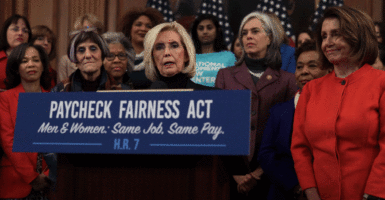In the name of fact-free social justice, legislators are trying to tell Americans how to run their businesses.
The House of Representatives is expected to pass H.R. 7 on Wednesday, misnamed as the Paycheck Fairness Act, along almost totally partisan lines.
The bill is a misguided, one-size-fits-all attempt to punish employers for any discrepancies in pay between men and women, regardless of what may be justifiable and legitimate reasons.
The proposal is based on a fundamental untruth that there is currently a significant wage gap based on sexual discrimination.
There is no “pay gap,” but instead a choice gap where salary differences between men and women are best explained by differences in education, choice of occupation, time in the official workforce, hours worked, and flexibility.
No one is arguing that women and men should be paid differently for the same work, despite the media and far left’s attempt to frame the debate this way.
Both the Equal Pay Act of 1963 and the Civil Rights Act of 1964 already prohibit discrimination on the basis of sex in the workplace.
What H.R. 7 attempts is a classic “swampball” play: Introduce a law titled after something no one can disagree with (like the Violence Against Women Act or the Clean Water Act) and then use it to usher in huge new government controls that benefit special interests.
In this case, trial lawyers benefit the most.
The law would allow for a cause of action for anyone who is paid less than someone in their workplace in a similar job, and would remove a previously existing $300,000 cap on damages, also automatically including all “injured parties” in a class-action discrimination lawsuit.
It would allow for onerous data collection and surrender by private companies to the federal government to make available for sifting through by litigious trial lawyers, essentially having the taxpayer subsidizing the discovery portion of litigation for them.
In short, it would be a huge boon for trial lawyers. Notably, lawyers appear as top donors on many of the co-sponsors’ campaign and PAC donor reports, including a whopping $78,522 to Rep. Rosa Delauro’s, D-Conn., 2018 campaign committee, according to Open Secrets.
The House is free to establish its own pay structure so long as it’s consistent with applicable federal law.
So the question is, why haven’t they imposed an H.R. 7 pay equality schedule on themselves? And if they did, what would happen?
The House provides a great test case for what an H.R. 7 regime could look like in practice.
The congressional body divides its staff neatly into certain job titles and regular career progressions. It is much easier to make comparisons on such a clean model than would be in other complex business organizations with varied titles, divisions, and structures.
In order to understand how legislative staff is paid and how the implementation of H.R. 7 would impact lawmakers, we pulled publicly available salary data from the third quarter of last year for 176 of H.R. 7’s co-sponsors.
The publicly available data, pulled from LegiStorm, is only available for members who were in Congress last year. Additionally, there are some anomalies (part-time staff, shared staff, partial employment during period, etc.), which were excluded from the dataset.
The data identifies a few trends that are inconsistent with the messaging surrounding the bill and would actually result in downward pressure for some female salaries.
Of the co-sponsors’ offices, female staff assistants make an average of $1,218 more than their male counterparts, female legislative correspondents $3,416 more, legislative assistants $4,755 more, and chiefs of staff $2,268 more.
Only male legislative and communications directors make more than their female counterparts, $5,761 and $693, respectively. So the question is: What accounts for these differences if not insidious discrimination based on sex?
There are countless possible justifiable explanations for these differences, but H.R. 7 would put the onus on proving that discrimination is not the reason behind any difference, it must be due to sex-based discrimination, and therefore should be remedied.
The result?
Under H.R. 7, male staffers could sue their members on the grounds of wage discrimination.
Unless members of congress could prove that it was a business necessity to pay female staffers more and that there was nothing they could have done to remedy pay (such as providing training to male staffers to bring their skills on par with female staffers), the members would not only have to reduce female staffers’ wages to bring them on par with male staffers’ wages, but they would have to compensate male staffers for past differences in wages, as well as potential unlimited punitive damages.
Again, the biggest beneficiaries would be trial lawyers who would walk away with much larger settlements than any individual staffer.
There is no reason to suspect that there is a rampant and sex-based discriminatory pay issue on Capitol Hill that is driving these members to compensate their staffs differently. And no serious person would call for lowering female staffers’ salaries based upon these numbers.
What these numbers do tell us is that a strict, central planning model would often result in fundamentally unfair and, in some instances, absurd applications.
Moreover, it tells us that H.R. 7 is another instance of out-of-touch Washington lawmakers telling American businesses how to run their operations while they themselves do they exact opposite.

























